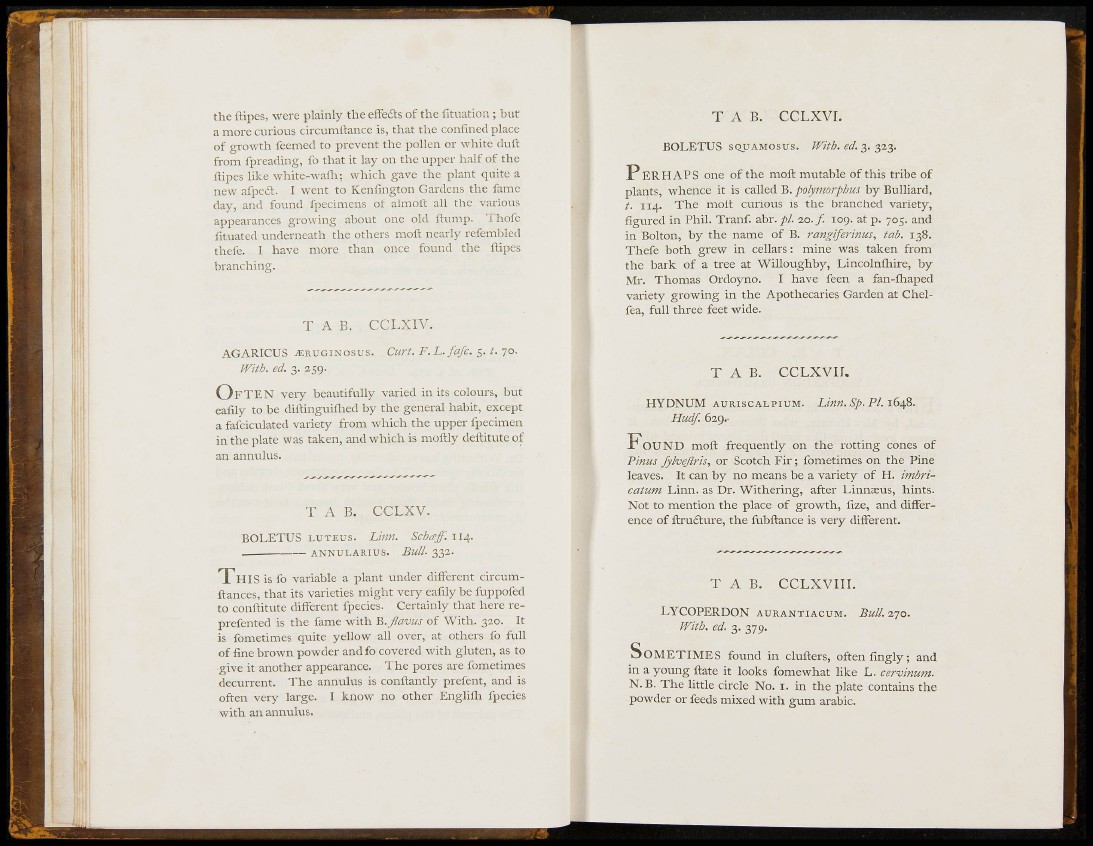
the ftipes, were plainly the efFeas of the fituation ; but
a more curious circumñance is, that the confined place
of growth feemed to prevent the pollen or white duft
from fpreading, ib that it lay on the upper half of the
ñipes like white-wafli; which gave the plant quite a
new afpeil. I went to Kenfington Gardens the fame
day, and found fpecimens of almoñ all the various
appearances growing about one old ñump. Thofc
fituated underneath the others moñ nearly refembled
thefe. I have more than once found the ftipes
branching.
T A B . CCLXIV.
AGARICUS ^RUGiNosus. Curt. F.L.fafc. 5. t. 70.
mth. ed. 3. 259.
O f t e n very beautifully varied in its colours, but
eaiily to be diftinguiflied by the general habit, except
a fafciculated variety from which the upper fpecimen
in the plate was taken, and which is moftly deftitute of
an annulus.
T A B . CCLXV.
BOLETUS LUTEUS. Linn.
ANNULARIUS.
114.
332'
T H I S is fo variable a plant under different circumftances,
that its varieties might very eafily be fuppofed
to conftitute different fpecies. Certainly that here reprefented
is the fame with B.flavus of With. 320. It
is fometimes quite yellow all over, at others fo full
of fine brown powder andfo covered with gluten, as to
give it another appearance. The pores are fometimes
decurrent. The annulus is conftantly prefent, and is
often very large. I know no other Englifh fpecies
with an annulus.
T A B . CCLXVI,
BOLETUS SQUAMOSUS. With. ed. 3. 323.
P E R H A P S one of the mofl mutable of this tribe of
plants, whence it is called B. polymorpbus by Bulliard,
t. 114. The mofl; curious is the branched variety,
figured in Phil. Tranf. abr. pi. 20./ 109. at p. 705. and
in Bolton, by the name of B. rangiferinus, tab. 138.
Thefe both grew in cellars: mine was taken from
the bark of a tree at Willoughby, Lincolniliire, by
Mr. Thomas Ordoyno. I have feen a fan-ihaped
variety growing in the Apothecaries Garden at Chelfea,
full three feet wide.
T A B . CCLXVII.
H Y D N U M AURISCALPIUM. Linn.Sp.Pl.164Z.
Hudf. 629.-
F o U N D moil frequently on the rotting cones of
Pinus fyhejlris, or Scotch Fir; fometimes on the Pine
leaves. It can by no means be a variety of H. imbricatum
Linn, as Dr. Withering, after Linnasus, hints.
Not to mention the place of growth, fize, and difference
of ftru6i;ure, the fubitance is very different.
T A B. CCLXVIIL
L Y C O P E R D O N AURANTIACUM.
With. ed. 3. 379.
Bull. 270.
S o m e t i m e s found in clufters, often fmgly; and
in a young ftate it looks fomewhat like L. cervinum.
N. B. The little circle No. i. in the plate contains the
powder or feeds mixed with gum arable.